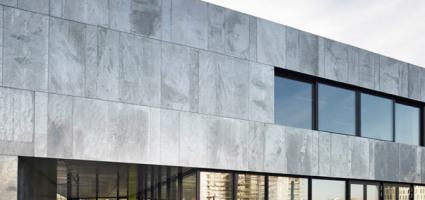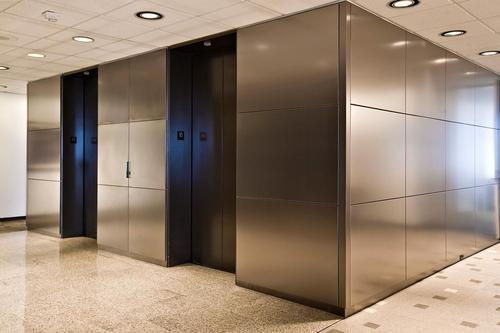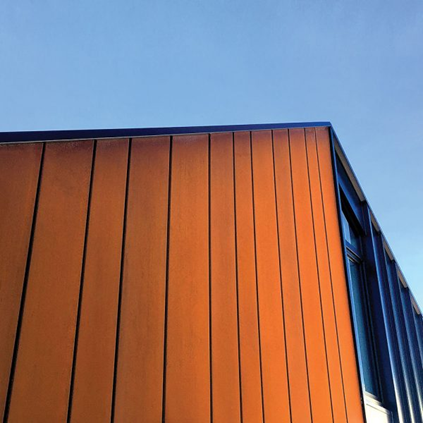- FMA
- The Fabricator
- FABTECH
- Canadian Metalworking
Categories
- Additive Manufacturing
- Aluminum Welding
- Arc Welding
- Assembly and Joining
- Automation and Robotics
- Bending and Forming
- Consumables
- Cutting and Weld Prep
- Electric Vehicles
- En Español
- Finishing
- Hydroforming
- Laser Cutting
- Laser Welding
- Machining
- Manufacturing Software
- Materials Handling
- Metals/Materials
- Oxyfuel Cutting
- Plasma Cutting
- Power Tools
- Punching and Other Holemaking
- Roll Forming
- Safety
- Sawing
- Shearing
- Shop Management
- Testing and Measuring
- Tube and Pipe Fabrication
- Tube and Pipe Production
- Waterjet Cutting
Industry Directory
Webcasts
Podcasts
FAB 40
Advertise
Subscribe
Account Login
Search
Choosing a metal for architectural cladding
Alloys, characteristics abound for weather protection, aesthetics
- By Superdraft Staff
- September 1, 2021
- Article
- Finishing
Although expensive, metals are the most durable material used for cladding in residential and commercial construction. Some are commonly used throughout all of manufacturing and construction, such as the ferrous metals, whereas others usually have specific niches, such as titanium and red metals.
Galvanized Steel
Because it’s abundant and not very expensive, iron is among the most commonly used metals for industrial purposes. Just a small amount of carbon and a few other elements turn it into steel, a family of metals with an abundance of favorable characteristics. Regrettably, the iron combines readily with oxygen to form rust; thankfully, just a thin coating of zinc is all that’s needed to provide an impressive resistance to corrosion.
A bonus is in the aesthetics. Galvanized steel develops visible crystallite patterns as a result of the zinc bonding with the steel. Cladding made from galvanized steel is a durable, eye-catching feature for exterior applications, especially for contemporary designs.
Stainless Steel
Like common carbon steel, stainless steel comes in many varieties. By varying the combination of the main alloying elements—chromium, molybdenum, and nickel—manufacturers optimize its corrosion resistance and its hardness (to vary the ease of machining and forming). The chromium reacts with oxygen, but it’s not a progressive reaction; the reaction comes to a stop at the surface and the material doesn’t degrade or deteriorate.
Cladding made from stainless steel gives any surface a clean and polished finish. These are great for both indoor and outdoor applications of modern buildings.
Weathering Steel
Known for its striking appearance, weathering steel is a favorite of many professionals in the construction industry. Initially marketed as COR-TEN, the consistent rustlike patina that develops over time is actually a protective layer that keeps the material from corroding. It also eliminates the need for repainting.
Weathering steel lends a rustic appearance to industrial-style homes and buildings.
Aluminum
Aluminum is another favorite metal to use in the manufacture of cladding materials. It boasts an excellent strength-to-weight ratio, allowing manufacturers to create panels that are less bulky but as strong as their steel counterparts. Also, aluminum acts like chromium. It bonds readily with oxygen to form a thin, hard layer of aluminum oxide, which protects the underlying material.
Aluminum cladding is suitable for contemporary and commercial construction projects. It needs to be installed and maintained by professionals because the material isn’t as hard as many other materials, leaving it prone to dents and scratches.
Titanium
Cladding made from titanium is a favorite because of its glossy and reflective surface. More than that, the metal is extremely durable and strong despite being lightweight. To make the material corrosion-resistant, manufacturers give it a protective oxide film. Once installed, the titanium cladding needs regular maintenance and cleaning to prevent damage.
Zinc
Zinc is well-suited to cladding because it has immunity from the harmful effects of the sun’s UV rays, has amazing corrosion resistance, and has a weatherproof surface. Best of all, this metal has self-healing properties, meaning scratches “heal” and disappear as time passes by.
Cladding materials made from zinc or coated with zinc are perfect for exterior applications.
Copper
Another durable metal used to manufacture cladding materials is copper. It is known for its beautiful reflective surface that oxidizes and develops a distinct green patina over time. This makes copper cladding recyclable. Sometimes people buy the copper cladding used in buildings before the structures get demolished.
Brass
Another metal alloy that develops a beautiful patina over time is brass. Cladding material made from brass is lustrous, then takes on a golden-brown patina as the surface oxidizes.
Manufacturers of brass cladding also find the material to be extremely malleable and well-suited for decorative sheet metal work.
In Summary
All are beautiful, and all have their own strengths and unique selling points.
If you are planning to use metal cladding on your project and you find it hard to choose, feel free to ask for your designer’s input.There are many factors to consider when choosing a metal cladding: the weather conditions, configuration, structural systems, application, finishes, appearance, nature of adjacent materials, maintenance, and budget. Getting professional design and construction advice is the best way to go.
About the Author
Superdraft Staff
162 Macquarie St. Level 2
Hobart, Australia
1300-936-740
subscribe now

The Fabricator is North America's leading magazine for the metal forming and fabricating industry. The magazine delivers the news, technical articles, and case histories that enable fabricators to do their jobs more efficiently. The Fabricator has served the industry since 1970.
start your free subscription- Stay connected from anywhere

Easily access valuable industry resources now with full access to the digital edition of The Fabricator.

Easily access valuable industry resources now with full access to the digital edition of The Welder.

Easily access valuable industry resources now with full access to the digital edition of The Tube and Pipe Journal.
- Podcasting
- Podcast:
- The Fabricator Podcast
- Published:
- 04/16/2024
- Running Time:
- 63:29
In this episode of The Fabricator Podcast, Caleb Chamberlain, co-founder and CEO of OSH Cut, discusses his company’s...
- Trending Articles
How to set a press brake backgauge manually

Capturing, recording equipment inspection data for FMEA

Tips for creating sheet metal tubes with perforations

Are two heads better than one in fiber laser cutting?

Hypertherm Associates implements Rapyuta Robotics AMRs in warehouse

- Industry Events
16th Annual Safety Conference
- April 30 - May 1, 2024
- Elgin,
Pipe and Tube Conference
- May 21 - 22, 2024
- Omaha, NE
World-Class Roll Forming Workshop
- June 5 - 6, 2024
- Louisville, KY
Advanced Laser Application Workshop
- June 25 - 27, 2024
- Novi, MI





























